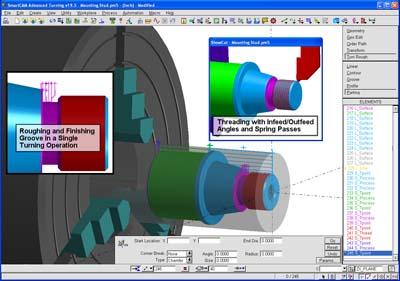
SmartCAMcnc has announced the release of SmartCAM V19.5. Version 19.5 continues the tradition of focusing the mid-year SmartCAM release on turning improvements, but also incorporates some milling enhancements that build on functionality introduced in version 19.0. Additionally, a substantial amount of core improvements are included that will benefit all SmartCAM users.
The SmartCAM product family consists of applications for CNC milling, turning, fabrication and wire EDM.
Core turning improvements include updated Threading and Groove Roughing capabilities, and a new Parting Process. The Threading Cycle now provides easy access to all threading parameters, and includes new thread options such as Infeed/Outfeed Angles, Start/End Extensions and Spring Passes. Additionally, Thread Blunting is now supported using an ID/OD groove tool in the threading cycle.
The Groove Roughing process has been significantly enhanced to include options to Cleanup Cusps, Finish-to-Size and Reverse Progression of cuts. The addition of cleanup and finishing passes allows the user to create the complete groove using a single process. Additionally, the geometry groove element can now be defined on a layer as a Groove Feature and used as input to any of the roughing processes, including Groove Rough, thereby providing a wide variety of machining strategy options.
"SmartCAM version 19.5 delivers significant core turning improvements. We've had many requests for improved threading and grooving capabilities, and are confident our users will be very pleased to see use this new functionality." said Douglas Oliver, SmartCAMcnc's Senior Product Manager.
A new Parting Process has been added that allows cut-off operations to be defined without the need of additional geometry construction. The Parting process allows radius or chamfer corner breaks to be applied to the edges on either side of the cut-off, and provides options for depth-pecking and controlling a part-catcher. This new feature saves time and improves accuracy and repeatability.
Several significant milling improvements are found in the version 19.5 milling applications as well as the mill/turn capabilities of SmartCAM Advanced Turning. The Part Offset path type introduced in the version 19.0 Region Rough process has been integrated into the other roughing processes such as Pocket, Face, Solid Pocket, and Planar roughing, and now supports the Stay Down option previously introduced for Spiral path type in v19.
Contact Details
Related Glossary Terms
- computer numerical control ( CNC)
computer numerical control ( CNC)
Microprocessor-based controller dedicated to a machine tool that permits the creation or modification of parts. Programmed numerical control activates the machine’s servos and spindle drives and controls the various machining operations. See DNC, direct numerical control; NC, numerical control.
- electrical-discharge machining ( EDM)
electrical-discharge machining ( EDM)
Process that vaporizes conductive materials by controlled application of pulsed electrical current that flows between a workpiece and electrode (tool) in a dielectric fluid. Permits machining shapes to tight accuracies without the internal stresses conventional machining often generates. Useful in diemaking.
- gang cutting ( milling)
gang cutting ( milling)
Machining with several cutters mounted on a single arbor, generally for simultaneous cutting.
- grooving
grooving
Machining grooves and shallow channels. Example: grooving ball-bearing raceways. Typically performed by tools that are capable of light cuts at high feed rates. Imparts high-quality finish.
- milling
milling
Machining operation in which metal or other material is removed by applying power to a rotating cutter. In vertical milling, the cutting tool is mounted vertically on the spindle. In horizontal milling, the cutting tool is mounted horizontally, either directly on the spindle or on an arbor. Horizontal milling is further broken down into conventional milling, where the cutter rotates opposite the direction of feed, or “up” into the workpiece; and climb milling, where the cutter rotates in the direction of feed, or “down” into the workpiece. Milling operations include plane or surface milling, endmilling, facemilling, angle milling, form milling and profiling.
- parting
parting
When used in lathe or screw-machine operations, this process separates a completed part from chuck-held or collet-fed stock by means of a very narrow, flat-end cutting, or parting, tool.
- threading
threading
Process of both external (e.g., thread milling) and internal (e.g., tapping, thread milling) cutting, turning and rolling of threads into particular material. Standardized specifications are available to determine the desired results of the threading process. Numerous thread-series designations are written for specific applications. Threading often is performed on a lathe. Specifications such as thread height are critical in determining the strength of the threads. The material used is taken into consideration in determining the expected results of any particular application for that threaded piece. In external threading, a calculated depth is required as well as a particular angle to the cut. To perform internal threading, the exact diameter to bore the hole is critical before threading. The threads are distinguished from one another by the amount of tolerance and/or allowance that is specified. See turning.
- turning
turning
Workpiece is held in a chuck, mounted on a face plate or secured between centers and rotated while a cutting tool, normally a single-point tool, is fed into it along its periphery or across its end or face. Takes the form of straight turning (cutting along the periphery of the workpiece); taper turning (creating a taper); step turning (turning different-size diameters on the same work); chamfering (beveling an edge or shoulder); facing (cutting on an end); turning threads (usually external but can be internal); roughing (high-volume metal removal); and finishing (final light cuts). Performed on lathes, turning centers, chucking machines, automatic screw machines and similar machines.
- wire EDM
wire EDM
Process similar to ram electrical-discharge machining except a small-diameter copper or brass wire is used as a traveling electrode. Usually used in conjunction with a CNC and only works when a part is to be cut completely through. A common analogy is wire electrical-discharge machining is like an ultraprecise, electrical, contour-sawing operation.
